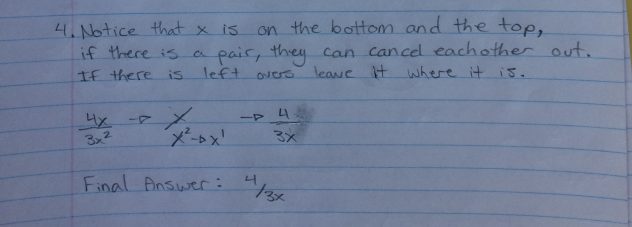Last week in Pre-Calculus 11 we learned about multiplying and dividing rational expressions. A thing to remember about expressions is that it does not have an equal sign and you do not need to solve, you only need to simplify. I will be teaching you what non-permissible values are and how to determine what they are.
Non-permissible value : Values that cause the fraction to have a denominator with a value of zero. (In math, we cannot divide by zero).
Here is an example of multiplying rational expressions
Steps:
Non permissible values:
- remove (x-3) from top and bottom because they cancel eachother out
- then it becomes…
Step 2: Simplify by multiplying across (Just do it)
Step 3: Take the highest common factor from both the numerator and the denominator.
In this case 6 is the highest number that goes into both.
Step 4: Notice that x is on the bottom and the top, if it has a pair it can cancel out. two x’s on the bottom one on the top. when they cancel out each other you will be left with only 1 on the bottom.
Final Answer:
Dividing Rational Expressions
There are many steps when dividing rational expressions
- Simplify the fraction: can factor or take out the common denominator.
- State the non permissible values.
- Reciprocate the second fraction and it will because a multiplication expression.
- State the restrictions again because there are new values in the denominator and could be non-permissible.
- Simplify (cancel out like terms that have a pair on the numerator and denominator.
- Multiply across (Just do it)
- Simplify again if possible.
Step 1: Simplify
FACTOR:
Step 2: Non-permissible values
Step 3: Reciprocate
Step 4: Non-permissible values
Step 5: Cross out like terms
Step 6: Multiply across if possible
- In this example it is not
Step 7: Simplify further if possible
- In this example it is not
Final Answer:
This is how you Multiply and Divide Rational Expressions









